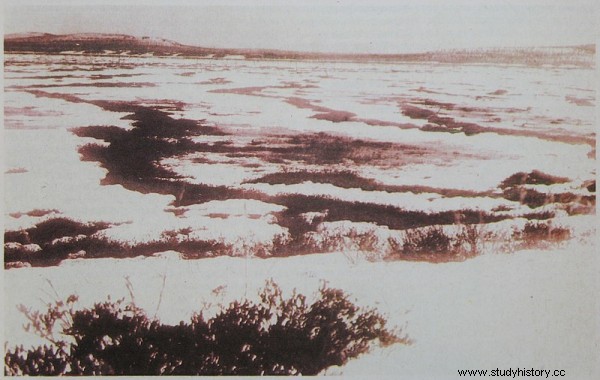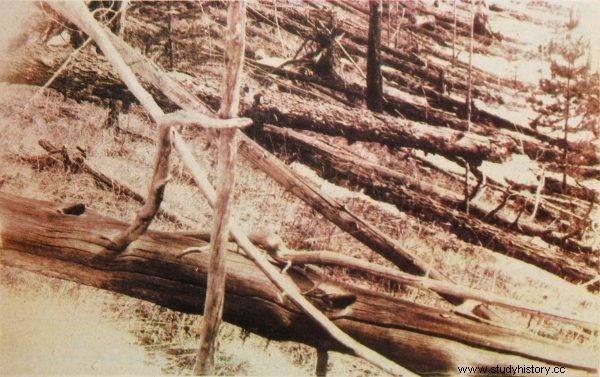On June 30, 1908, a powerful explosion took place over Siberia. The cause of it has not been clarified to this day. What has been established about the Tunguska disaster?
A seismic wave that circled the Earth twice. Nights as bright as days. Millions of fallen trees. Temporary new magnetic pole. Giant fires. Is this a description of the consequences of a nuclear explosion? Well no. This is the result of a mysterious car explosion over Siberia. Mysterious because to this day it has not been possible to establish what exactly it was.
Great Siberian explosion
Everything happened on June 30, 1908, a dozen or so minutes after 7:00 am local time, north of Lake Baikal, about 70–80 kilometers from the Vanowar trading post, on the Podkamienna Tunguska River. A mysterious object moving from southeast to northwest appeared in the sky , trailing a fiery streak behind it. Soon after, a powerful explosion took place over the taiga in the middle of Siberia . It resulted in a seismic wave that circled our planet twice before finally losing its momentum. After 5 hours, weather stations in Western Europe observed the pressure surge caused by it. The power of the explosion is estimated at around 10 to even 15 megatons of trinitrotoluene or colloquially speaking TNT or TNT.

Visualization showing the size of the explosion
The noise accompanying the explosion was heard from a distance of as much as 1000 km, over an area of one million km 2 . He caused temporary deafness in shepherds located 20 km from the epicenter. The flash was visible up to 650 km from the site where it took place. The resulting smoke column rose to a height of about 20 kilometers. This event is now known as the Tunguska disaster, the Tunguska event or even the great Siberian explosion.
Nights turned bright as days
The destruction of the natural environment was almost unimaginable. The explosion also produced a thermal wave. Fires broke out over a huge area. On the surface of 2,000 km 2 - or as Anglo-Saxon sources want 830 mil 2 - trees were literally felled. Their number is estimated at 60 million . The fire raged in the surrounding area for weeks more.
The Tunguska disaster has also become a source of extremely unusual phenomena. If we had used a magnetometer near the crash site, it would point to the other magnetic north pole. However, this is not the end of the story. After all, after the explosion in Europe and Asia, the nights were extremely bright , comparable to the white nights. This was because the blast had lifted gigantic amounts of dust into the stratosphere. Its millions of tons traveled mighty distances, reflecting sunlight. As a result, even at night it was possible to read the fine print without having to switch on the lamp.
Expeditions to the scene
Should a disaster like this occur today, research teams would probably be there the very next day. It took ... 19 years for the scientists of the time to reach the place where the explosion took place. Of course, their technical abilities were diametrically worse, but political factors and quite high instability in Russia and the "young" Soviet Union contributed significantly to that.

Crash site around 1930
The first team to arrive on the site was on April 13, 1927, led by Leonid Kulik from the Russian Academy of Sciences. He had already laid the ground for this expedition during the "reconnaissance" expedition in 1921–1922. A few years later, Wanowara became his base. Two decades after the disaster, its effects were still visible:radiant fallen trees and traces of massive fires. Breaking through the inhospitable terrain, on May 30, Leonid Kulik suspected, the probable site of the space car crash was found - a lake that fits into a 5 by 10 km rectangle. Was it an impact crater?
Surprisingly, burned and barkless trees were also noticed in the area, but still standing upright. Some even survived the explosion. However, the expedition had to complete its research quite early as its food supplies were exhausted. The activities carried out on the site were resumed the following year, when an attempt was made to locate the meteoric matter. Nothing was found. And this even despite drilling.
Cosmic catastrophe
Another important research was carried out after the Second World War. In 1962, a team led by geochemist Kirill Floreński collected soil samples from the scene. They were later analyzed for the presence of space materials, namely particles formed when a potential meteoroid decays and burns. Thanks to this research, was able to find cosmic dust as well as molten metal particles.
Over the years, various concepts have developed to explain what exactly happened in 1908. The most common were those saying that the cause of the Tunguska catastrophe was a meteorite or a comet. A related opinion was given, among others, by in 1979 by Professor Nikolai Vasiliev, a member of the USSR Academy of Medical Sciences.
Several years earlier, at the Ninth International Meteorite Conference in 1960, Vasily Fiesenkov suggested that the comet nucleus had caused the catastrophe. Some scientists thought it might have been an ice comet that had evaporated in the atmosphere. According to others, the comet would even be radioactive . However, calculations of the orbits of the "suspect" known comets showed that they were too far from our planet.

Fallen and burned trees at the site of the Tunguska disaster
Science and science fiction explanations
In 1990, the astronomer - this time Croatian - Korado Korlevic stated that the cause of the explosion was a meteorite, comparable in size to skyscrapers. According to other opinions, it could have been a stone meteorite with a diameter of as much as 60 meters, which disintegrated after entering the Earth's atmosphere and which exploded at an altitude of 10 kilometers. Years earlier, Leonid Kulik also suspected the same.
This is related to the opinion of the geologist Marek Żbik. Recall: no meteor shard was physically found. According to him, the weight of the car at the time of entering the atmosphere was even about a million tons, but its structure was quite fragile, which caused it to crash after colliding with the tropospheric layers. He also believed that it could be a fragment of an asteroid (or even a comet) composed of carbonaceous chondrite.
There were also slightly more… niche opinions. Some of them made more sense than others. In 1984, for example, Soviet geophysicists Viktor Żurawiew and Alexei Dimitriev suggested that the cause of the Tunguska catastrophe may have been a plasmoid detached from the Sun. There were even those who claimed that the swamp gas that exploded was responsible for everything.
The author of the most extreme explanation of what happened is certainly the Soviet writer Alexander Kazanceev. Well, he developed a theory straight from science-fiction movies according to which the explosion was caused by ... a space rocket from Mars returning from Venus an atomic engine exploded along the way! Of course, we can put this explanation into fairy tales. Regardless of what caused the Tunguska event, it was surely one of the greatest catastrophes of "our" time.
